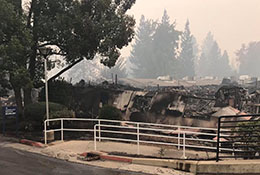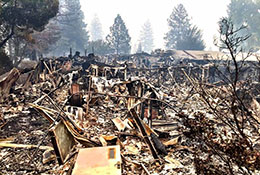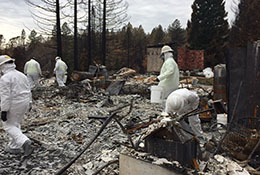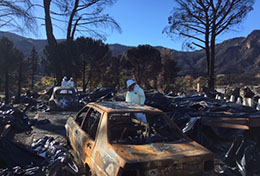Office of Public Affairs For Immediate Release: December 11, 2018
For Immediate Release: December 11, 2018
News Release #2018-23
Media Contact: opa@calrecycle.ca.gov
Media Contact: CalOES Newsroom
916-800-3943 | media@caloes.ca.gov
SACRAMENTO – The California Department of Resources Recycling and Recovery, in partnership with the Governor’s Office of Emergency Services; Butte, Los Angeles, and Ventura counties; the California Department of Toxic Substances Control; the U.S. Environmental Protection Agency; the Federal Emergency Management Agency; and other federal, state, and local partners, has begun the process of clearing debris following the most destructive series of wildfires in California history.
State-managed debris removal programs have been established in Butte, Los Angeles, and Ventura counties to clear household hazardous waste and other fire debris from more than 14,000 properties destroyed by the Camp, Woolsey, and Hill fires.




Cal OES photos of properties destroyed by the Camp Fire in Butte County (left, middle left) and DTSC photos of household hazardous waste removal crews assessing and clearing properties burned in the Camp and Woolsey Fires (middle right, right).
Consolidated Debris Removal Program
Implemented under the leadership of CalOES and local governments, the Consolidated Debris Removal Program mobilizes federal, state, and local resources to help restore burned properties under a two-phase cleanup process.
Phase 1: Crews managed by DTSC and U.S. EPA remove household hazardous waste such as paints, cleaners, solvents, oils, batteries, pesticides, compressed cylinders and tanks, and easily identifiable asbestos.
- Started Dec. 3, 2018, by U.S. EPA and DTSC crews.
- Learn more about the HHW removal process.
Phase 2: Following the removal of household hazardous waste, CalRecycle-managed contractors remove the remaining asbestos, assess and document properties, and remove contaminated soil, ash, metal, concrete, and other debris to restore properties to pre-fire conditions.
- Preliminary damage assessments started Nov. 28 by CalRecycle crews.
- Learn more about the debris removal process.
CalRecycle oversees and manages contractors and consultants to conduct debris removal (Phase 2) at no out-of-pocket cost to property owners. To participate in Phase 2 of the state-managed debris removal program, owners must grant cleanup crews access to their property by returning signed Right-of-Entry agreements to their local government.
Right of Entry Forms:
- Butte County
- Los Angeles County PDF download
- Ventura County
Property owners who wish to conduct their own cleanup may do so, but they should be aware of local safety and environmental standards and requirements. Contact your local government for more information on private cleanups.
CalRecycle Wildfire Debris Removal Update
Crews managed by CalRecycle are wrapping up work on four previous debris removal operations following wildfires in Shasta, Lake, and Siskiyou counties.
| Fire (County) | Participating Properties | Debris Removal Complete | Final Inspections Complete | Tonnage Removed |
|---|---|---|---|---|
| Pawnee (Lake) | 15 | 15 | 15 | Est 2,600 |
| Mendocino Complex (Lake) | 154 | 126 | 25 | Est 33,582+ |
| Carr (Shasta) | 1,044 | 1,038 | 657 | Est 514,558+ |
| Klamathon (Siskiyou) | 49 | 49 | *46 | Est 14,829 |
*Three lots returned to the county and referred to DTSC for additional mitigation measures
Final soil testing, the installation of erosion control measures, and final property inspections are on track to be complete in the coming weeks. Upon final inspections, property owners receive certification from their county that verifies their lot is clean and eligible to receive a building permit.
For more information contact, the Office of Public Affairs, opa@calrecycle.ca.gov

Home Page | News Releases | Public Meetings | Event Calendar | Videos | Publications | Organics | Bottles and Cans
CalRecycle's mission is to protect California's environment and climate for the health and prosperity of future generations through the reduction, reuse and recycling of California resources, environmental education, disaster recovery, and the transition from a disposable to a fully circular economy.
